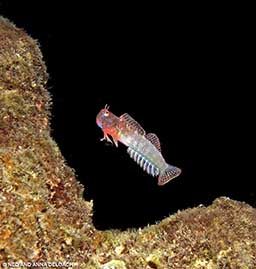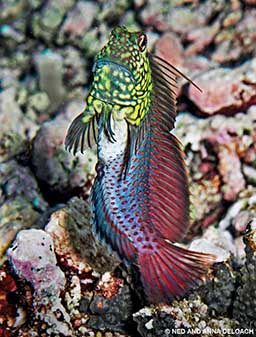If you were a blenny living in a hole, how would you attract a mate? Anna discovered a delightfully surprising answer this past spring while hunting blennies along the wave-battered shoreline encircling Triton Bay in West Papua, Indonesia. To be more precise, she solved the mystery for a few species of combtooth blennies — the cute, clunky, half-finger-long, Muppet-faced algae eaters she found hunkered down inside urchin holes bored just below the tide line.

I wasn’t surprised to see Anna and a friend head toward the shallows on our first dive of the trip after our recent visit with Phil Hastings, a blenny behaviorist at Scripps Institution of Oceanography in La Jolla, California. During the stopover, Hastings showed us a video revealing a wide range of blenny courtship displays — part of his work involves cataloging the behaviors to better understand the evolutionary history of the Blenniidae family. Inspired, Anna sailed into Triton Bay with serious blenny hunting on her mind.
Finding and photographing blennies in the surge has more in common with mud wrestling than reef diving, but Anna always wants pictures when she is on a mission. After lunch, when she mentions finding something special along the shoreline, I wince and begin making excuses. But this time she is ready with her laptop keyed to a piece of footage she shot that morning. The 10-second sequence follows the leap of a distinctive two-tone blenny with its fins spread — an impressive feat for a hydrodynamically challenged bottom dweller without a swim bladder.
“It’s a throatspot blenny,” Anna blurts out. “Bet you didn’t recognize it. It sure doesn’t look anything like the ones we’ve been finding. Must be one of Dr. Hastings’ courting males begging for eggs. What do you think?”
With color change, water-column acrobatics and the intrigue of sexual selection rolled into one, it’s right up my alley. “I’m all in,” I answer, cavalierly disregarding the bruises my body is about to sustain.

Laying eggs in nests prepared, tended and guarded by males is common practice for small female reef fishes — primarily damselfishes, gobies and blennies. When hormones seasonally surge through blenny populations, egg-laying females — always in short supply — make competition fierce. Some males bob incessantly to get attention, while others lunge, nudge, flare oversized fins or bite; but none of these tactics compare to the pure bravado of signal jumps.
Three days pass before the seas settle enough for us to tackle the shallows. We bail out of the skiff shortly after sunrise when egg layers are most active and just arrive at a tumble of boulders when Anna waves us over and points to a small hole with a black head sticking out. The next thing we know we’re lifted off the rock and swept seaward. After regaining control and taking a couple of deep breaths, we ride a swell back to shore just in time to see a throatspot blenny fly high off the bottom. Wedging in a crevice to thwart the swells, we begin to see others across the rock face pop out of their holes like pistons. At the pinnacle of each jump, males pause in suspended splendor for two, maybe three, seconds before turning tail and diving for cover.

Bright colors and conspicuous displays that demonstrate a male’s fitness have both costs and benefits. How they play against each other under the competing influences of natural selection and sexual selection is the dickens to figure out. For a small fish, leaving a hiding hole is life-threatening business. At the same time, willfully darting up into open water and wearing eye-catching colors fly in the face of natural selection. As the thinking goes, the daredevil behavior evolved to either intimidate rival males with prowess or entice females to nests with beauty — then again, it could be a means of demonstrating the safety of a spawning site, or all of the above. Whatever the reason, the performance seems to work, especially for larger males, which seem to always attract multiple females on multiple days.
Over a string of semicalm mornings, Anna and I track blennies in shallower and shallower water until we’re swimming with our eyes above the surface like hippos with 35-pound cylinders on our backs. Our amphibious assaults lead us to a group of combtooth blennies known as lipsuckers, basking together on the surface of seaside rocks kept moist by ocean spray.
Our blenny-fest doesn’t miss a beat when we sail west into the Banda Sea. Instead of hunting the shoreline, we explore shallow coral gardens on alert for the red-streaked blenny — a beefy, 5-inch beauty that builds egg burrows in rubble patches adjacent to living coral. Once again, Anna rises to the occasion, this time finding a leaping red-streaked blenny turning green for love.
| © Alert Diver — Q4 2018 |